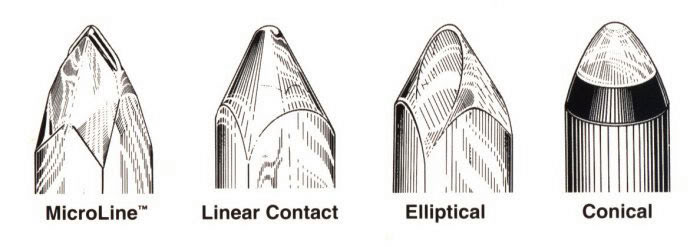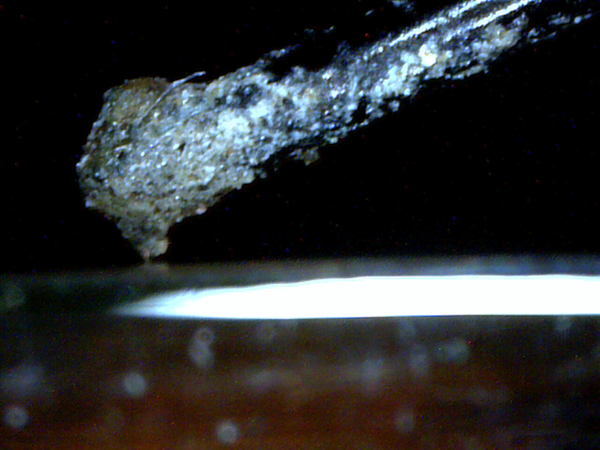Stylus Tips 101
An audio component that often gets overlooked by many is the almighty stylus. We at Real Groovy care about the protection of your records so it might pay to keep on reading, especially if you can't remember the last time you changed your stylus.
What is a stylus (plural: Styli)?
The stylus (or needle) is the tip that sits in the groove of the record. As it hits the walls of the groove, it vibrates the cantilever, capturing the magic stored within. The vibrations from the cantilever excites the magnetic pickup inside the cartridge, which converts them into electrical energy…thus becoming SOUND! The end result can be greatly affected by how worn the stylus is, as well as the type of stylus you have.
What types of styli are there?
There are plenty of different shaped styli out there...I’m going to only list the main varieties that we see on a daily basis.

Spherical (or Conical):
Being the least expensive option, it is no surprise that this is the most common type of stylus used. Visually, the spherical shape looks similar to the tip of a ballpoint pen. This shape has a larger radius making it impossible to track the smaller high-frequency groove modulations.
Its only disadvantage is that the overall sound quality has less detail, however, the main advantage is less surface noise caused by dust and debris. Some might say that this particular shape is considerably kinder to your records than it’s elliptical counterparts, but this opinion isn’t held by many as a lot of spherical cartridges require a tracking force greater than 3 grams.
Elliptical (or Bi-Radial):
Having two radii, the elliptical stylus (or more accurately, biradial) makes more contact with a larger area of the groove walls, allowing for more precise tracking. Resulting in a much richer sound whilst tracking at a lighter weight, it is no surprise that this is an upgrade from the spherical stylus shape.
Something to be mindful of is that the alignment of the cartridge and tonearm need to be spot-on. A misaligned stylus will sit in the groove unevenly, resulting in inner groove sibilance (or distortion). Also, it is no surprise that the stylus tip would wear out a lot quicker given that this particular shape is more involved. A well-worn elliptical stylus tends to be a lot less forgiving than the spherical shape.
Hyperelliptical (including Shibata, Fine Line, Stereohedron):
To put it in simple terms, the hyperelliptical stylus is basically the elliptical but on drugs. These styli are specifically designed to increase the amount of physical contact with the record in order to produce an even finer sound.They’re also made to be more robust, so stylus wear is not as bad as the elliptical. Because these styli tend to be a little more complicated to manufacture, they are extremely expensive.
How often should I change my stylus?
Most stylus manufacturers recommend replacing your stylus every 1000 hours of playback. Unfortunately a lot of people take that recommendation to heart, and don’t realize that their well worn stylus is actually doing damage...especially if you have an elliptical.
A worn stylus surprisingly doesn’t have much of a noticeable change in sound quality. Once you hear the difference, that stylus has already done irreversible damage to your records. Inner groove wear won’t make them unplayable, however, it will lower the value of your records significantly.

Here are some Real Groovy tips for stylus longevity:
Keep your records clean
Dust and grime trapped in the groove of your records can affect the overall sound...but it can also do damage to your stylus. Keeping an anti-static carbon fibre brush nearby will save you and your stylus. It would pay to give your records a deep clean every now and then too! Depending on how they’re kept, you may have to give them a deep clean once every two - three years. Remember to replace those inner sleeves too...what ever is on the record will be on the sleeve!
Keep your stylus clean
A good stylus brush with a drop of isopropyl alcohol will help keep your stylus clean. If you are against using alcohol based solutions, these do exist too! It pays to be super gentle when using the stylus brush as the cantilever is very fragile.
Keep your tonearm latch in place when you aren’t using it
You’d be surprised at how many styli get ruined by people absentmindedly knocking the tonearm...children tend to be the usual suspects, however, adults are just as bad. We are human after all!
Ensure your tracking force is set correctly
Be mindful of how much weight you have set on your tonearm. A stylus that is tracked heavier than needed will wear out quicker and you may do damage. A lighter tracked stylus will have trouble staying in the groove. It always pays to go in between the two recommended tracking forces as stated by the stylus manufacturer. A tracking force pressure gauge will do the trick!
Be mindful of how long each listening session is
Some people keep a little notebook by their turntable to take note of how many hours they spent listening. Others give themselves a strict window to listen to records. People that don’t listen to records that often, it’s best to set an exact date that you will replace your stylus.
What If I have a moving coil cartridge? How do I replace the stylus on that?
Unfortunately the stylus on a moving coil cartridge can only be re-tipped. If you get in touch with the manufacturer of your particular cartridge, they may be able to suggest where to send it to, otherwise you will need to replace the whole cartridge.
If you can’t remember when you last changed your stylus, change it immediately. If you recently purchased a second hand turntable, change that stylus. Before purchasing the turntable, I would recommend searching for a replacement because quite a lot of cartridges and styli have been discontinued. Some turntables are also not upgradeable due to compatibility so you don’t want to be stuck with a dud. Just give us a call on 0800 GROOVY or email [email protected] and we will be happy to help you out!